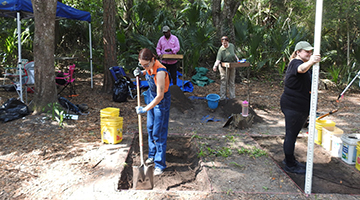UNF Archaeology Lab unveils new finds at lost Indigenous village of Sarabay
 In a wooded area on Big Talbot Island, between the St. Johns River and the Atlantic Ocean, a group of University of North Florida students dig carefully in the dirt.
In a wooded area on Big Talbot Island, between the St. Johns River and the Atlantic Ocean, a group of University of North Florida students dig carefully in the dirt.
The site was first uncovered by UNF in 1998 about 20 miles north of Jacksonville, Fla. Then four years ago, UNF Archaeology Lab Director Keith Ashley proposed students again take to the field.
UNF students moved beyond reading about archaeology in textbooks to touching pieces of the past and having a direct physical connection to the lives of the Indigenous people who once inhabited Northeast Florida.
Digging centimeter by centimeter. Meter by meter.
Discovering the village
The discoveries are vast and include more than 15,000 pieces of Indigenous pottery, more than 100 pieces of Spanish olive jar, colorful majolica plate fragments and religious imagery, demonstrating interactions with a nearby friar on an adjacent island and the colony of St. Augustine about 50 miles by water to the south.
Students also found stains in the soil from where large posts once anchored structures. As they found more and more posts, they realized they were working within the footprint of what was once a structure about 50 to 60 feet in diameter.
Archaeologists believe this would have been called a council house and served as a public building for gatherings, recreation and political and religious activities.
It turns out UNF faculty and students found an area where not just a few people once lived.
They had uncovered the lost Indigenous village of Sarabay.
The search continues
After the UNF Archaeology Lab first discovered Sarabay in 2020, the team is currently undertaking one of the most intensive and extensive excavations at a Timucua village in the state of Florida. Through the current implementation of a four-year field project (2020-23), the students, faculty and volunteers are excavating broad areas in search of houses, activity areas and other buildings.
The Mocama-speaking Timucua Indians of northeastern Florida were among the first Indigenous populations of Florida encountered by European explorers in the 1560s. Documents written by the French and Spanish describe Timucua villages and hint at the locations. While the actual whereabouts of most of these villages had gone undetected for nearly 450 years, testing by the UNF Archaeology Lab has identified the archaeological location of the village of Sarabay at the Armellino site on Big Talbot Island, Florida.
This project, part of UNF’s larger Mocama Archaeological Project that first began in the 1990s, will provide a solid database for sixteenth-century Timucua settlements and allow students the opportunity to touch the ancient past of Northeast Florida.
